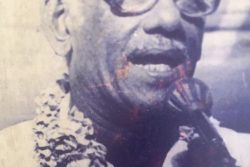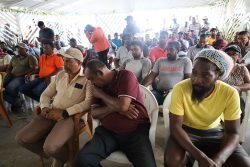Mashramani, like other kindred national festivals such as Barbados’ Crop Over and the Jamaica Festival, was created to cement and celebrate nationhood through an exhibition of the carnivalesque, to bring the populace together in a spirit of cooperation and oneness as well as to showcase to itself and the world, a definition of the nation’s cultural character and traditions.
In previous discussions we have already attempted to explain the origin and history of these festivals, why they are similar, where they are different and how they compare in terms of achievement, present character and cultural traditions. In the Caribbean there is one major factor that accounts for the greatest similarity among all the territories and their national festivals. That is the carnivalesque. It is manifested by the tendency to move almost naturally into street parades, masques and masquing (the popular term ‘mas’), artistry, music and revelry.
Having said that, the greatest difference may be found in the other side of this factor. That is, carnival itself. In this part of the world there is a group of carnival countries in which carnival is the major festival as well as the major cultural influence and tradition. These are Brazil, Trinidad and the whole Eastern Caribbean; the OECS territories, especially St Vincent with its famous brand ‘Vinci-mas,’ Antigua and St Kitts/Nevis. Jamaica, Barbados, the Bahamas and Guyana fall outside of this carnival belt and share a number of differences within a similar history. They never had carnival with its depth of historical and cultural development over the centuries since 1783 when the French settlers, who were already established in the Eastern Caribbean, were invited into Trinidad and were responsible for the merging of a range of rich cultural traditions.
Of those four non-carnival countries, Barbados’ Crop-Over has the most significant historical depth since it draws strength from the customary harvest celebrations on sugar plantations since the eighteenth century. However, this historical development was never continuous or direct. There were various small starts and stops in the 1950s and 1960s until the real official founding of Crop-Over in its present form in the late 1970s. The Jamaica Festival was created in 1962 to celebrate the nation’s independence. What it lacked in length of history it made up for in cultural depth. It managed to incorporate already existing rich traditions, some linked to Emancipation, including traditional music and dance, as well as exhibitions of literature, music, drama and the fine arts, to establish a very strong and rewarding celebration in July and August.
Least in complexity is the Bahamas, where the festival consists of the Gumbay (goombay) masque performance. This is built on a very long-standing masquerade or jonkunnu (or John Canoe) tradition also known in Jamaica with powerful developments in the eighteenth century. The Bahamian gumbay has several masques and dances and there is also a satirical topical issue performance, characteristic of the Caribbean carnivalesque. It was to this common carnivalesque that all these countries – Jamaica, Barbados, Bahamas and Guyana – turned when looking for a form of public celebration.
There have been several references to the Guyana festival, Mashramani, which was officially created in 1970 to celebrate the nation’s status as a Republic. Falling back on the carnivalesque, it adopted, adapted, co-opted and brought together elements of already existing celebrations. It then carved out the name mashramani from an Amerindian tradition in order to exploit the spirit of cooperativism and jollification celebrated there. Another advantage of the Amerindian derivative was that it lent national identity to the celebration. The Mashramani idea, therefore, suggests a nation, a republic, built after cooperative work, celebrating its achievement, defining itself and showcasing its cultural store.
Despite being less defined than the corresponding national festivals of its Caricom neighbours in terms of its cultural character, cultural history and traditions, Guyana’s Mashramani has come a very long way. It is now firmly established as a popular tradition attracting all cross-sections of the population.
However, arriving at this high point was never easy or unproblematic. It has suffered experiences unheard-of in the festivals of the other territories. Since the 1970s to 1980s Mashramani has had to overcome political abuse, ruling party misappropriation, alienation of sections of the community, reduction to state participation, the disinterest of the private sector, as well as Guyana’s unique brand of race politics and divisiveness. Carrying over into the 1990s it further suffered poor administration, imitation of carnival and diffusion of identity, another wave of attempts at racial alienation by groups dismissing it as an “African” festival, and government disinterest.
All those failed to diminish or stop Mashramani’s march to establishment as a tradition entrenched in the popular culture. An important contributor to this remarkable growth has been the government turn-around in attitude and interest during the administration of the energetic Minister Teixeira from around 1998 through to Minister Xavier’s presiding over one of the most successful celebrations in 2006. The race, politics and divisions were seemingly vanquished and the festival began to look like taking on an identity of its own with a declared interest in tourism.
However, it is as a potential tourism product that it still lags way behind the celebrations of its neighbours. There may be a significant number of arrivals made up of Guyanese living abroad, but the potential has not yet been realised. Mashramani is older than Crop-Over, yet the Kadooment festival is leagues ahead as a tourism product, in marketing, commercial possibilities and realisations. Both Crop-Over and Trinidad’s carnival are superior money-spinners with untold millions in earnings. To date, Guyana’s Mashramani is not organised in any way to move in that direction.
To be fair, Mashramani seems still driven by an ideology based on the virtues of regional involvement and opportunity, rather than any commercial or profit-making interest. This causes the major competitions such as the Calypso King, the Chutney Monarch and the Soca Monarch to be staged in far-flung areas like Bartica, Lethem and Blairmont, among others, which take them out of Georgetown and the major population centres. This is accompanied by no real attempt to organise them into major national shows attended by appropriate, elaborate, artistic and attractive production with the preliminaries in the outer regions, if you like, but the grand finals sold as elaborate major affairs better placed to attract the largest audiences in the metropolitan centre.
As if to definitely negate any such grandeur or importance, however, the 2007 competitions in calypso, soca and chutney were deliberately fixed to clash with each other. Eliminations, semi-finals and finals were all knowingly arranged to take place simultaneously. This meant no singer could enter more than just one of them. This meant no member of the public, or any visitor or tourist (!) could go to see more than just one of them. The virtue or gain of such an arrangement is not immediately obvious.
The demand of the popular culture inspired Barbados to create the ‘Party Monarch’ and develop it into a grand affair with the finals at the party excursion setting of the ‘East Coast’ Bathsheba beach location. While this is outside of Bridgetown, the population centre, it is a very popular, attractive and appropriate setting for the event, for revelry and as a tourism product. The corresponding Mashramani affair does not begin to compare. In Barbados, on the other hand, the rivalry in both calypso and ‘party’ soca competitions is extremely fierce if not downright bitter. Although Guyana needs none of that, it has followed to the letter. The Barbadian contests are notorious for an
nual controversies, protests and quarrels. Rivalry is good, but there was no need for the other vices. Yet Guyana followed, making it is possible in Mashramani for a contestant to be officially awarded the Soca crown only to have the decision reversed when the defending champion and popular favourite did not win.
To date, the branding, packaging and marketing of Mashramani are not on the road to making it capable of drawing large crowds of visitors. Great enthusiasm has now been generated around the festival, but there is still very little entrepreneurial zeal at the level of international marketing. Yet even internally, little is still done to maximize the local potential. Both sectors are targeted by Crop-Over and Carnival to make their box offices glow as if caressed by Midas. Without tarnishing the social ideology, Guyana can take steps to deliberately study the models in Trinidad and Barbados with a view to making Mashramani a money earner rather than dependent on the Ministry of Culture’s budget. At any rate, it is not difficult to commission a local study of the commercial potential, as was recently done for Carifesta. That ought to be less difficult now because of the reasonable base provided by the heights presently attained by the festival.









